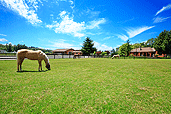The World's Largest Equestrian Real Estate Website. Founded in 2005.
 In The Wizard of Oz, Dorothy exclaims, "We're not in Kansas anymore, Todo. "This of course points to Kansas' physical location in what's been termed, Tornado Alley. The legendary Chisholm Trail is much more than some fictional roadway in an old cowboy Western. The trail informally connected the cattle yards of Texas with those outside Kansas City. This was the route by which cowboys moved herds, but the trail also became a route for people heading West during the mid to late 1800s.
In The Wizard of Oz, Dorothy exclaims, "We're not in Kansas anymore, Todo. "This of course points to Kansas' physical location in what's been termed, Tornado Alley. The legendary Chisholm Trail is much more than some fictional roadway in an old cowboy Western. The trail informally connected the cattle yards of Texas with those outside Kansas City. This was the route by which cowboys moved herds, but the trail also became a route for people heading West during the mid to late 1800s.
A trend is afoot to give your state soil a name. Kansas chose the name, "Harney Silt Loam" to describe their top layer of earth. According to the U.S. Natural Resources Conservation Service, the soil combines the best soil attributes to support the predominantly grain-centric agricultural economy. And in fact there's a reason that grain naturally grows so well in the prairie states: the already grassy plains break down the surface of the soil over time; what's left is a beautiful and loamy layer that is well suited to supporting the needs of a wide range of grain crops. Most of the larger cities are in Eastern Kansas, which tends to be surprisingly hilly and have more trees and water than other parts of the state.
| Kansas in Numbers: | |||||||||||||||||||||
|
© 2024. HorseProperties.net®. All rights reserved.